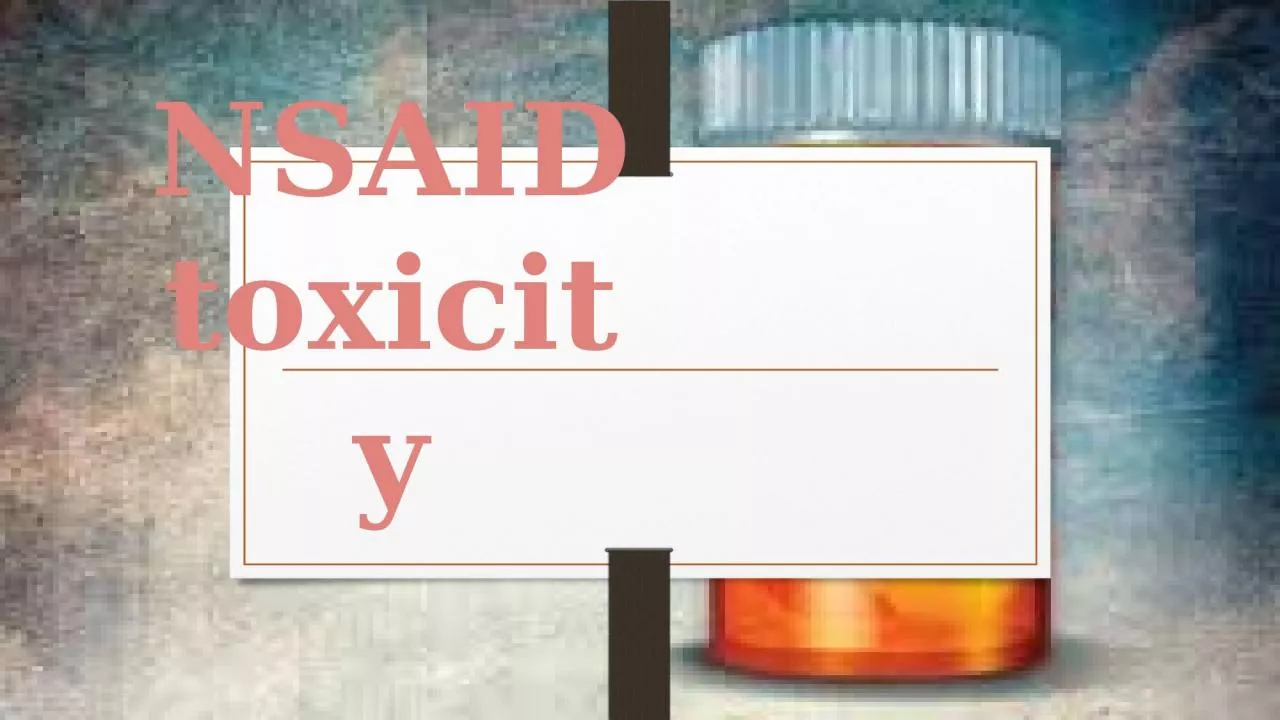

Now we can talk about its toxicity The therapeutic and many of the toxic effects of the NSAIDs result from inhibition of the enzymes in the cyclooxygenase COX group This results in a decrease in the synthesis of prostaglandins and thromboxane A2 from the precursor ID: 934417
Download Presentation The PPT/PDF document "NSAID toxicity How do NSAIDs work first ..." is the property of its rightful owner. Permission is granted to download and print the materials on this web site for personal, non-commercial use only, and to display it on your personal computer provided you do not modify the materials and that you retain all copyright notices contained in the materials. By downloading content from our website, you accept the terms of this agreement.
Slide1
NSAID toxicity
Slide2How do NSAIDs work first ??
Slide3Now, we can talk about its toxicity
Slide4The therapeutic, and many of the
toxic
effects of the NSAIDs result from
inhibition
of the enzymes in the cyclooxygenase (COX) group. This results in a decrease in the synthesis of prostaglandins and thromboxane A2, from the precursor
arachidonic
acid
.
The mechanism of toxicity of NSAIDs in overdose appears to predominantly be as a result of excessive inhibition of COX-1 and subsequent reduction in prostaglandin synthesis. The metabolic acidosis seen in severe NSAID toxicity is not related to COX inhibition, but to the accumulation of acidic
metabolites.
Slide5This acidosis
is more common in children
as they are more susceptible to it. It is dose
dependant
, toxic dose needed in adult to be complicated with acidosis which need only large therapeutic dose in children to cause acidosis.
Metabolic acidosis is
due to
:
1.Accumulation of organic acids due to impaired CHO metabolism.
2.Accumulation of end products of salicylates (
gentesic
&
salcyluric
acid).
3.R.C. depression.
The
gastrointestinal, renal and central nervous systems (CNS) are predominantly affected, both in therapeutic use and in acute overdose.
Slide6NSAID toxicity may be
Chronic
Acute
Slide7Chronic toxicity
Severe poisoning and death as a result of acute poisoning with NSAIDs is extremely uncommon. The majority of cases remain asymptomatic or develop only minor gastrointestinal symptoms
.
Chronic toxicity of salicylate is called
salicylism
and manifested by the following :
Slide8Tinnitus
Decreased hearing
Headache
Confusion
Blurred vision
Nausea
Vomiting
Slide9To treat the chronic toxicity
we should stop the drug immediately . And give the patient symptomatic treatment to overcome this state. For example to free the body from the drug we can make forced alkaline diuresis that increase
its excretion.
Slide10Patterns of toxicity in acute NSAID overdose
Ibuprofen
is the most widely used NSAID and
become
one of the most commonly overdosed drugs in many
countries.
As a result of this, ibuprofen is the NSAID with the most published data in acute overdose and a number of large series confirm that most patients with ibuprofen toxicity develop few significant clinical features
.
Slide11Gastrointestinal toxicity in acute NSAID overdose
In acute NSAID overdose reports of nausea,
vomiting, hyperacidity
and
epigastric
discomfort are common and are usually the most prominent symptoms
.
Significant upper gastrointestinal hemorrhage following NSAID overdose is rare. There is one reported case in a 50-year-old female who presented after an overdose of 24–36 g of ibuprofen who developed upper GI bleeding but did not require blood
transfusion.
Slide12Renal toxicity in acute NSAID overdose
In acute overdose, renal impairment has been reported in patients with underlying renal and cardiovascular disease, but also in previously healthy individuals following large ingestions of
ibuprofen,
diclofenac
,
naproxen
and
mefenamic
acid. Although this is partly due to the role of prostaglandins in maintaining renal blood flow.
Slide13In a prospective
study
of 61 cases of ibuprofen overdose, there was only one report of renal failure in a 64-year-old male with ingestion of 407 mg/kg of
ibuprofen.
This patient subsequently
died.
In the majority of cases, renal impairment is reversible and responsive to supportive care and intravenous
fluids.
However, there are reports of patients with acute NSAID toxicity requiring renal replacement therapy
.
Slide14Neurological toxicity in acute NSAID overdose
Drowsiness, confusion,
nystagmus
, blurred vision, diplopia, headache and tinnitus have been reported following overdose of ibuprofen,
diclofenac
and naproxen and
mefenamic
acid
.
Generalized convulsions occurring as a result of acute overdose of NSAIDs are predominantly associated with mefenamic acid overdose, but have also been reported following acute
supratherapeutic doses of ibuprofen in children.
Slide15Acute toxicity
is also associated with hyperthermia, hyperglycemia, hypotension, circulatory collapse, hypo-
prothrombinemia
& bleeding tendency.
Slide16Can we treat acute toxicity?!
yes, we can.
let’s see how
Slide17There is
no specific anti-dote
and the
treatment is mainly
symptomatic.
Artificial respiration.
Gastric lavage.
Forced alkaline diuresis to enhance renal excretion.
Haemodialysis
if renal failure occurs.
Anticonvulsants as
Diazepam. Vit. K for bleeding tendency & ice bags and cooling.
Slide18